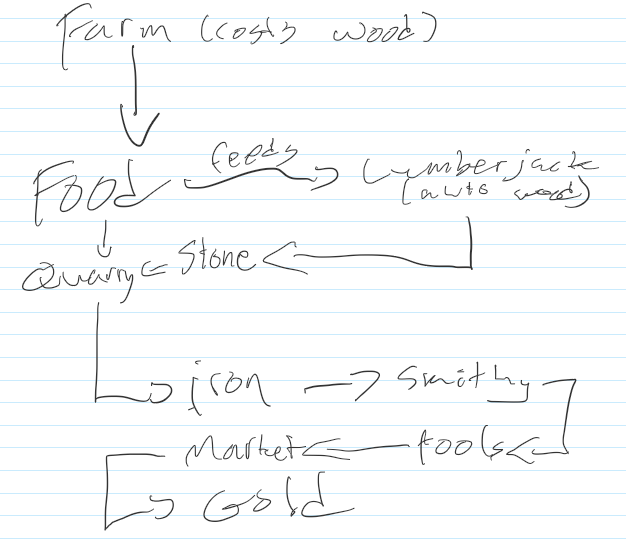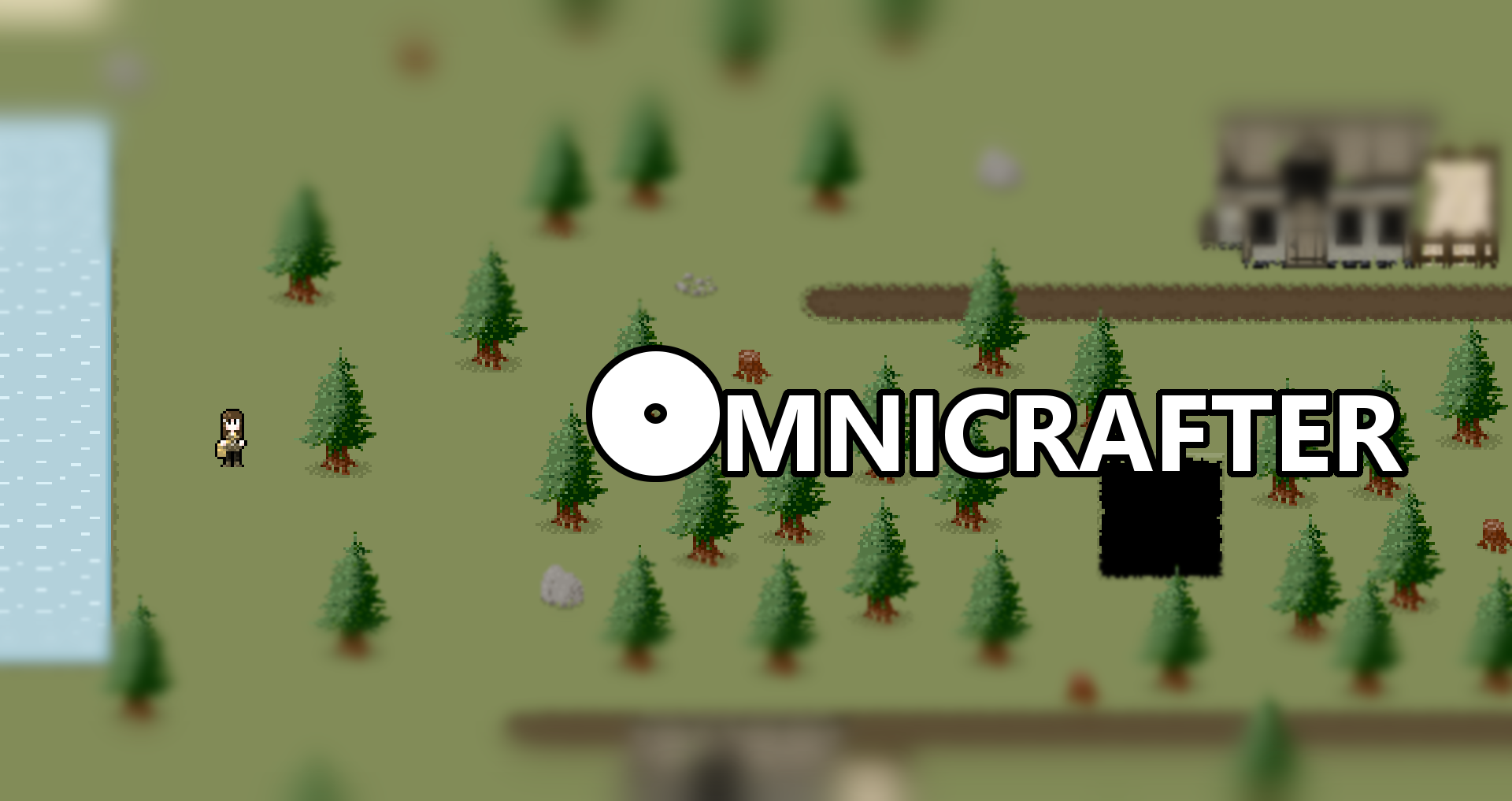Omnicrafter Mission Statement
Hello again everyone! Thank you for staying with the project so far. This week, I’m going to be talking about the core mission statement or “high concept” of the game, as well as my thought process and inspirations leading up to it. I’ll also be sharing some screenshots of my notes (which, fair warning, are terrible handwriting wise). I’ll do my best to explain everything that I can. Feel free to comment if you have any questions unanswered by this post.
To start with, here are the first notes I ever wrote about this game. The idea came to me while playing Anno 1800 of all games, and was further solidified after playing Forager and the Longing.

So, what do these notes really mean? While a lot of them are self explanatory, they were by necessity short hand – I was merely writing them down so I would not forget the idea while it was bouncing around in my head.
I am, at my core, a multitasker. It’s a chronic problem I have, blamed on my ADHD. I love all sorts of games, but often I wish I could be playing several at once. While this is viable to some extent (playing some mobile game whilst playing an MMORPG on my PC), it is rather difficult in other regards. For instance, one of my favorite genres is Strategy games and city builders. One afternoon, I was playing Anno 1800 whilst trying to play some Final Fantasy XIV in the background. In addition to the sheer resource intensiveness of Anno making switching between the games very difficult, the amount of attention Anno requires at all times makes multitasking with it impossible despite it being the sort of game I want to play constantly.
And you pretty much have to play Anno constantly – one session, at least for me, can last all day. Meaning I’ll have planned to get some work done on this game or on some other project, but I decide to take a break and boot up Anno. I tell myself I’ll only play for an hour and then, the next thing I know, eight hours have passed and it’s time for me to go to bed. You can see my dilemma here; I want to watch my city grow and expand it, but it’s simply impossible to multi-task with a game that requires so much attention despite it being such a long-form game.
I am of the opinion that games requiring such large time investments should be something you experience at your own pace. Something you can have passively running in the background while you focus on other tasks, only taking an hour or two of your active time each day if even that. At first, I wrote off the entire idle game genre as too casual for my tastes, without enough complex systems to really hold my attention and with no real substance outside of numbers getting bigger as you progress.
That’s when I heard of the game called The Longing. A story driven game that takes an entire year to complete (though there are ways to speed up the progression of time if you properly explore). Though I never finished the game, what I did play of it I absolutely adored. It was this game that made me realize the untapped potential of Idle Games as a genre; they weren’t just cash grabs or browser based number-generators. They could tell stories and even have engaging concepts. Whilst story driven games are great and all, I began to think on the potential of the Anno franchise made idle.
The idea fermented in my mind for a few more weeks, when I came across the game Forager. This game is sort of like Minecraft from a top down perspective, with a more idle-able angle. The game requires some degree of active attention to make sure you don’t starve or have monsters destroy your structures, but all in all was very friendly towards multitaskers such as myself. However, it didn’t really go far enough for me. Forager, whilst a great game, is focused on the crafting aspect. I want a game that has crafting elements, but can also be considered a proper city builder.
So it was that Idle Adventure - what you now know as Omnicrafter - was born. The movement and mechanics of Forager, mixed with the slow but variable pace of The Longing, mixed further with the resource automation and town management of Anno.
Of course, the game has evolved to have its own unique character since then. It won’t have the scope of Anno – I simply do not have the experience or resources to make a city builder on that scale realistically. Instead, expect something like Stardew Valley meets Forager meets simple city builder. The main Anno inspiration comes from the nature of the resource gathering system.
You see, in Anno 1800, every resource requires previous resources to gather or make it. For instance, in order to make canned food, in addition to a cannery you also need iron to make the cans, as well as beef and pepper to make the goulash that goes into the cans. Organizing your supply and production chains is, essentially, the core of Anno. I believe that something like this lends itself well to the idle game style, with some key twists.
In Idle Games, especially clickers, a core goal of the game is to make your numbers get bigger and bigger. With a game like Cookie Clicker, you start off by getting 1 new cookie each time you click. However, eventually you can purchase upgrades which allow you to gather more at a time – later even automating the entire process by recruiting grandmothers and constructing factories.
What if those factories existed on the game world? And what if the end reward wasn’t simply numbers, but more resources you could use to gather even further resources and lead to more automation? That is the core gameplay ‘objective’ and satisfaction of Omnicrafter. At the start of the game, you will be chopping down trees, mining rocks, crafting tools all on your lonesome from scratch. But once you’ve gathered enough, you’ll be building lumberjacks, smithies, quarries, and so on to do all of that for you. Each resource ‘tier’ feeds into the next one, so nothing is irrelevant; you will simply be working on the cutting edge of what is available whilst your village does the rest for you.
Below is a chart of the resource progression I have in mind for the demo.

Food is the core resource currently needed for just about everything. You can’t gather it on your own – instead, you gather wood and build farms. Farms will passively generate food over time. Whenever another building tries to gather a resource, it will consume a certain amount of food (for now just 1 for everything). If there is no food available, the building will be unable to gather anything until more food is gathered. Essentially, food is an upkeep resource.
Once you have gathered enough wood with the aid of lumberjacks, you will be able to upgrade your tool, allowing you to harvest stone. This is about how far the demo currently is, development wise.
The next step is going to be a quarry building to automate stone gathering, followed by an iron resource. A smithy will make tools, which are sold at the market for gold – the final resource tier for the prototype. Like food, gold will not be gatherable – instead, it is generated solely by the market.
The system may seem simple, and it is, but remember that this is all just for the demo. If the game proves popular enough, I will develop it into a game with far larger scope and scale, with potential future features including a proper population system, resource trading, combat, rougelike resource dungeons, and more. But for now, I simply wish to make a baseline, playable gathering-crafting-building game to spread the word and hone my skills.
Thank you for reading this. Tune in next week for a progress report on just how close I am to releasing a playable demo.
Omnicrafter
An idle game with city-building and adventuring elements.
More posts
- Dialog SystemFeb 26, 2021
- Lumberjacks and a General UpdateFeb 19, 2021
- Minor UpdateFeb 05, 2021
- What is left to be doneJan 29, 2021
- Where we areJan 16, 2021

Leave a comment
Log in with itch.io to leave a comment.